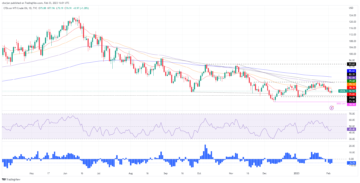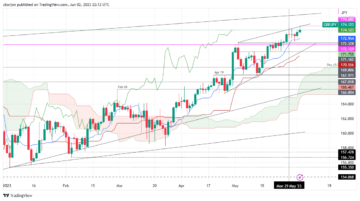- The Pound Sterling moves higher to 1.2480 as investors see the BoE delaying rate cuts.
- UK’s stable wage growth is limiting the slowdown in price pressures.
- The US Dollar corrects despite the Fed’s stance towards keeping interest rates higher for a longer period.
The Pound Sterling (GBP) retreats from 1.2480 in Thursday’s early New York session. The GBP/USD pair falls back as the US Dollar recovers amid expectations that the Federal Reserve (Fed) will keep interest rates higher for a longer period.
The US Dollar Index (DXY), which tracks the US Dollar against six major currencies, rises sharply from 105.75. The near-term demand for the US Dollar remains intact as Federal Reserve (Fed) policymakers keep emphasising the need for interest rates to remain higher for a longer period until they get convinced that inflation will return sustainably to the 2% target.
Meanwhile, expectations that the Bank of England (BoE) will delay rate cuts until the November meeting rose as the United Kingdom inflation for March decelerated slower than expected. Like the Federal Reserve (Fed), the BoE is also expected to delay rate cuts, which has faded potential fears of policy divergence between them.
The major catalyst that forced traders to pare BoE early rate cuts is the slow progress in inflation declining to the 2% target due to steady wage growth. The labor market report for the quarter ending February showed that Average Earnings including bonuses grew steadily by 5.6%, higher than expectations of 5.5%.
For inflation to return to the 2% target, the annual wage growth excluding bonuses should be close to 3.5%. Higher wage growth feeds inflationary pressures as businesses pass on labor cost to end consumers. Also, households with higher income for disposal ramp up overall demand in the economy.
Daily digest market movers: Pound Sterling surrenders intraday gains while US Dollar recovers
- The Pound Sterling falls from 1.2480 even though persistence in the United Kingdom’s inflation data for March forced traders to price out expectations for the Bank of England pivoting to rate cuts in the September meeting.
- Investors expect that the last mile for inflation to return to the 2% target will be bumpy. Currently, financial markets anticipate the BoE reducing interest rates only once this year in the November meeting.
- The UK Inflation data released on Wednesday indicated that annual core CPI data, which strips off volatile food and energy prices, grew by 4.2% year-over-year in March, above the consensus of 4.1% but significantly decelerated from February’s reading of 4.5%. The core inflation data is the Bank of England’s preferred inflation measure for decision-making on interest rates.
- A lower-than-expected decline in price pressures in March, combined with steady wage growth data for the three months ending February, forced traders to pare rate cut bets for the September meeting.
- After the release of the inflation data, BoE Governor Andrew Bailey said, “We’re pretty much on track for where we thought we would be in February on inflation. Bailey remains optimistic about a further drop in inflation next month. When asked about the impact of Middle East tensions, Bailey commented that the Oil price has not leaped as much as expected and the consequences of Middle East tensions are less than feared, reported FXStreet. https://www.fxstreet.com/news/boes-a-bailey-inflation-will-drop-strongly-in-the-next-month-202404171612
Technical Analysis: Pound Sterling drops from 1.2500
The Pound Sterling aims for firm footing after discovering strong buying interest near the round-level support of 1.2400. The GBP/USD pair rebounds from 1.2400 and focuses on recapturing the psychological resistance of 1.2500.
The near-term outlook of the Cable remains bearish due to a breakdown of the Head and Shoulder pattern and a declining 20-day Exponential Moving Average (EMA) near 1.2560.
In addition, the 14-period Relative Strength Index (RSI) oscillates inside the bearish range of 20.00-40.00, suggesting momentum leaned to the downside.
- SEO Powered Content & PR Distribution. Get Amplified Today.
- PlatoData.Network Vertical Generative Ai. Empower Yourself. Access Here.
- PlatoAiStream. Web3 Intelligence. Knowledge Amplified. Access Here.
- PlatoESG. Carbon, CleanTech, Energy, Environment, Solar, Waste Management. Access Here.
- PlatoHealth. Biotech and Clinical Trials Intelligence. Access Here.
- Source: https://www.fxstreet.com/news/pound-sterling-exhibits-strength-as-traders-scale-back-boe-rate-cut-bets-202404180816
- :has
- :is
- :not
- :where
- $UP
- 00
- 1
- 2%
- 20
- 2500
- 4
- 5
- 75
- a
- About
- above
- addition
- After
- against
- aims
- also
- Amid
- analysis
- and
- Andrew
- Andrew Bailey
- annual
- anticipate
- ARE
- AS
- asked
- average
- back
- BAILeY
- Bank
- Bank of England
- BE
- bearish
- Bets
- between
- BoE
- bonuses
- Breakdown
- bumpy
- businesses
- but
- Buying
- by
- cable
- Catalyst
- Close
- combined
- commented
- Consensus
- Consequences
- Consumers
- convinced
- Core
- core inflation
- Cost
- CPI
- CPI data
- currencies
- Currently
- Cut
- cuts
- data
- Decision Making
- Decline
- Declining
- delay
- Demand
- Despite
- Digest
- discovering
- disposal
- Divergence
- Dollar
- dollar index
- downside
- Drop
- Drops
- due
- Dxy
- Early
- Earnings
- East
- economy
- EMA
- emphasising
- end
- ending
- energy
- energy prices
- England
- England’s
- Ether (ETH)
- Even
- excluding
- expect
- expectations
- expected
- exponential
- exponential moving average
- Falls
- fears
- February
- Fed
- Federal
- federal reserve
- financial
- Firm
- focuses
- food
- For
- forced
- from
- further
- GBP
- GBP/USD
- get
- Governor
- grew
- Growth
- head
- higher
- households
- HTTPS
- Impact
- improves
- in
- Including
- Income
- index
- indicated
- inflation
- Inflationary
- Inflationary pressures
- inside
- interest
- Interest Rates
- Investors
- Keep
- keeping
- Kingdom
- labor
- labor market
- Last
- last mile
- less
- like
- limiting
- longer
- major
- March
- Market
- Market Report
- market sentiment
- Markets
- measure
- meeting
- Middle
- Middle East
- mile
- Momentum
- Month
- months
- Movers
- moves
- moving
- moving average
- much
- Near
- Need
- New
- next
- November
- of
- off
- Oil
- oil price
- on
- once
- only
- Optimistic
- out
- Outlook
- overall
- pair
- pass
- Pattern
- period
- persistence
- plato
- Plato Data Intelligence
- PlatoData
- policy
- policymakers
- potential
- pound
- pound sterling
- preferred
- pressures
- pretty
- price
- Prices
- Progress
- psychological
- Quarter
- Ramp
- range
- Rate
- Rates
- Reading
- Recovers
- reducing
- relative
- relative strength index
- Relative Strength Index (RSI)
- release
- released
- remain
- remains
- report
- Reported
- Reserve
- Resistance
- return
- Rises
- ROSE
- rsi
- Said
- see
- sentiment
- September
- session
- should
- showed
- significantly
- SIX
- slow
- Slowdown
- slower
- stable
- stance
- steadily
- steady
- sterling
- strength
- strong
- support
- sustainably
- Target
- tensions
- than
- that
- The
- the United Kingdom
- Them
- they
- this
- this year
- thought
- three
- to
- towards
- track
- tracks
- Traders
- Uk
- UK Inflation
- United
- United Kingdom
- until
- us
- US Dollar
- US Dollar Index
- volatile
- wage
- we
- Wednesday
- when
- which
- while
- will
- with
- would
- year
- zephyrnet



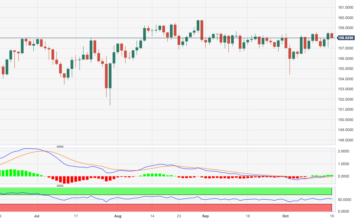
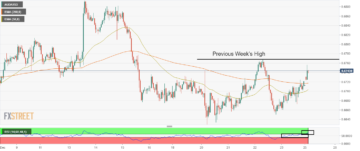
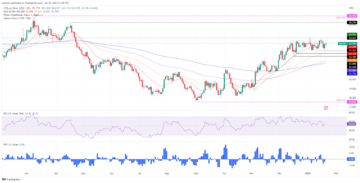

![Pound Sterling Price News and Forecast: GBP/USD slips on record debt, soft PMIs [Video]](https://platoaistream.net/wp-content/uploads/2023/01/pound-sterling-price-news-and-forecast-gbp-usd-slips-on-record-debt-soft-pmis-video-360x167.png)

![McDonald’s Corp. Elliott Wave technical analysis [Video]](https://platoaistream.net/wp-content/uploads/2024/03/mcdonalds-corp-elliott-wave-technical-analysis-video-360x209.png)
